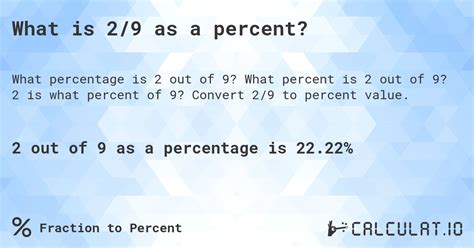2 Is What Percent Of 9
Kalali
Apr 02, 2025 · 4 min read

Table of Contents
2 is What Percent of 9? A Comprehensive Guide to Percentage Calculations
Understanding percentages is a fundamental skill applicable across numerous fields, from everyday budgeting and shopping to complex scientific analyses and financial modeling. This article delves into the seemingly simple question, "2 is what percent of 9?", providing a thorough explanation of the underlying principles and demonstrating various methods for solving this type of percentage problem. We'll explore different approaches, catering to various levels of mathematical understanding, and emphasize the practical applications of percentage calculations.
Understanding Percentages: The Basics
A percentage represents a fraction of 100. The term "percent" literally means "out of 100" (per centum in Latin). So, when we say "x percent," we mean x out of every 100 units. For instance, 50% means 50 out of 100, which is equivalent to the fraction 50/100, or the decimal 0.5.
Method 1: Using the Percentage Formula
The most straightforward approach to determining what percentage 2 represents of 9 involves applying the basic percentage formula:
(Part / Whole) x 100% = Percentage
In our case:
- Part: 2 (the number we want to express as a percentage)
- Whole: 9 (the total number)
Substituting these values into the formula:
(2 / 9) x 100% = Percentage
Calculating this:
(0.222...) x 100% ≈ 22.22%
Therefore, 2 is approximately 22.22% of 9. The ellipsis (...) indicates that the decimal 0.222... continues infinitely. For practical purposes, we round to a reasonable number of decimal places.
Method 2: Setting up a Proportion
Another effective method utilizes proportions. We can set up a proportion to solve for the unknown percentage (let's call it 'x'):
2/9 = x/100
To solve for x, we cross-multiply:
9x = 200
Then, divide both sides by 9:
x = 200/9 ≈ 22.22%
This method reaffirms our previous result: 2 is approximately 22.22% of 9.
Method 3: Using Decimal Conversion
This method involves first converting the fraction 2/9 into a decimal and then multiplying by 100% to express it as a percentage.
2 divided by 9 is approximately 0.222...
Multiplying 0.222... by 100 gives us approximately 22.22%. Again, we arrive at the same result.
Rounding and Precision
Note that in all methods, we encounter a repeating decimal (0.222...). The level of precision required depends on the context. For many purposes, rounding to two decimal places (22.22%) is sufficient. However, in situations demanding higher accuracy, more decimal places might be necessary.
Practical Applications of Percentage Calculations
Understanding percentage calculations is crucial in a wide variety of situations:
- Retail and Sales: Calculating discounts, markups, sales tax, and profit margins. For example, if a store offers a 22.22% discount on an item originally priced at $9, the discount amount would be approximately $2.
- Finance: Determining interest rates, calculating returns on investments, and analyzing financial statements. Understanding percentage changes in stock prices or loan interest is essential for financial literacy.
- Science and Statistics: Representing data in percentages, calculating statistical measures (e.g., percentages of a population), and expressing experimental results. Scientists frequently express their findings using percentages.
- Everyday Life: Calculating tips in restaurants, understanding nutritional information on food labels (e.g., percentage of daily value), and interpreting survey results.
Beyond the Basics: More Complex Percentage Problems
While the problem "2 is what percent of 9?" is relatively simple, the fundamental principles can be extended to more complex scenarios. For example:
- Finding the whole: If 20% of a number is 4, what is the number? This requires rearranging the percentage formula to solve for the "whole."
- Finding the part: What is 35% of 60? This involves applying the formula directly.
- Percentage increase/decrease: If a value increases from 5 to 7, what is the percentage increase? This requires calculating the difference, dividing by the original value, and multiplying by 100%.
- Compound interest: This involves calculating interest on both the principal and accumulated interest.
Mastering Percentage Calculations: Tips and Tricks
- Practice regularly: The more you practice solving percentage problems, the more comfortable you'll become with the various methods and their applications.
- Understand the concepts: Don't just memorize formulas; understand the underlying principles of percentages and their relationship to fractions and decimals.
- Use calculators effectively: Calculators can significantly speed up the process, particularly for more complex problems.
- Check your work: Always review your calculations to ensure accuracy.
- Break down complex problems: If a problem seems overwhelming, break it down into smaller, more manageable steps.
Conclusion
The question, "2 is what percent of 9?" serves as an excellent starting point for understanding the fundamental principles of percentage calculations. By mastering these principles and the various methods for solving percentage problems, you equip yourself with a valuable skillset applicable across numerous aspects of life, both personal and professional. Whether you're navigating financial decisions, interpreting scientific data, or simply understanding discounts at the store, a solid grasp of percentages empowers you to make informed choices and solve real-world problems effectively. The approximate answer, 22.22%, is just the beginning of a much broader understanding of this essential mathematical concept.
Latest Posts
Latest Posts
-
How Does Pulmonary Circulation Differ From Coronary Circulation
Apr 03, 2025
-
60 Ml Is How Many Ounces
Apr 03, 2025
-
How Much Feet Is 66 Inches
Apr 03, 2025
-
How Do You Find The Mean On A Dot Plot
Apr 03, 2025
-
What Is 20 Percent Of 130
Apr 03, 2025
Related Post
Thank you for visiting our website which covers about 2 Is What Percent Of 9 . We hope the information provided has been useful to you. Feel free to contact us if you have any questions or need further assistance. See you next time and don't miss to bookmark.
